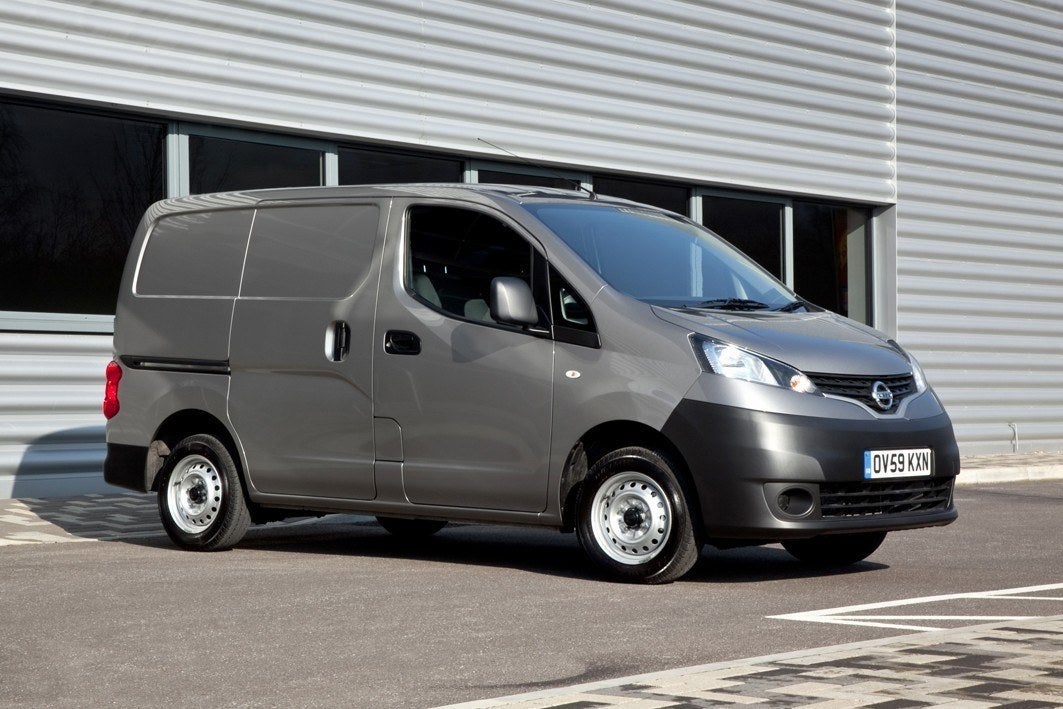Nissan NV200 (2009-2019) Review
Written by Andrew Brady
- 2009
- Van
- Diesel, EV
Quick overview
Pros
- Quiet and refined for a small van
- First to offer an electric model
- Big loading bay
Cons
- Very few engine options
- Poor payload
- Utilitarian cabin
Overall Verdict
"The Nissan NV200 is something of a rarity in the van world, and the Nissan van range, as it is a model that was developed by the brand itself. It was the smallest model in the company’s range, along with the larger NV300 and NV400. It was launched in 2009 and was on sale for 10 years until it was replaced by the NV250 in 2019."
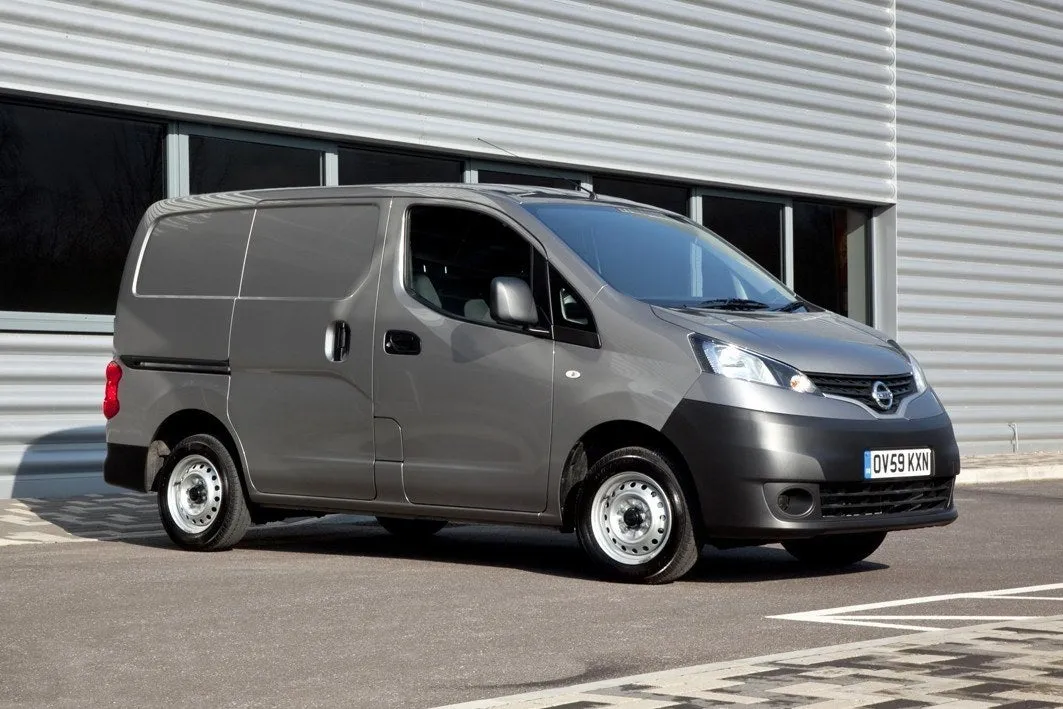
It features light steering and tight turning circle that make it a practical model for urban drop-offs, but it is not out of its comfort zone on the motorway either. Its relatively small exterior dimensions help it nip around town, too.
Despite these diminutive dimensions, the NV200 is surprisingly practical with a cargo bay that is 1.22m wide at the narrowest part and a decent 2.04m long that means you can fit two Europallets in. This overall length can be extended with a folding partition that means you can carry items up to 2.8m long. Handily, the NV200 also has the lowest loading height in its class, with a lip that is just 524mm from the ground.
The cabin is best described as utilitarian rather than luxurious. There are loads of storage spaces dotted around, the seats are comfortable and the dash is clear and easy to read, but it is not a fancy place to be.
The engine range is a simple one and always has been, with a 1.5-litre diesel the main offering. As of 2014, though, an electric version - the Nissan e-NV200 has been part of the range. This has featured the same battery and range as Nissan’s electric family hatchback, the Leaf. This version remained on sale after the NV200 was replaced by the NV250 and features a 40kWh drivetrain and an official WLTP range of 124 miles.
Both the diesel and the electric model are available as a panel van and as a combi, with either five or seven seats. Even the seven-seater retains a strong degree of practicality, with a big enough luggage space for a pair of suitcases. Fold those seats away and you can get another three suitcases in there too.
The NV200 is one of the quietest vans in its class, managing to keep its cabin impressively free of wind, road and engine noise. This is even more the case in the eNV200, which is gloriously silent.
The diesel engine was offered with 90PS or 110PS in its time, with the lower powered version nippy around town. On faster roads the 90PS model has to be worked a bit harder, so the 110PS is the more relaxed option if longer faster roads are to form a regular part of your working day.
The NV200 is an enjoyable van to drive down those faster roads, though, thanks to the rapid steering and lack of body lean when it comes to heading around corners. That lack of lean means that the ride is slightly harsh at other times, although it keeps things in enough check to stop short of being uncomfortable.
There is only the one length and height of NV200, which is one thing that could be levelled at it as a criticism, but the version that exists is impressive in many areas.
Looking for a used van for sale? We've got 100s of Nissan Approved Used Cars for Sale for you to choose from, including a wide range of Nissan NV200 vans for sale.
Is the Nissan NV200 right for you?
As small vans go the Nissan NV200 will tick a lot of boxes. It will suit those, in particular, who want a van that is familiar to drive for those more used to being behind the wheel of a car. It lacks a bit on the style front, but it more than makes up for it in how useful it is. The 795kg maximum payload might be short of that offered by many rivals but the space on offer will cover the needs of most users.
Despite being only available in one size, the NV200’s capacity is bigger than many of the standard versions of its direct equivalents – you’d have to compare it to the long-wheelbase version of its rivals to get the same loading ability.
The simplicity of the range will appeal to some, too – you won’t get bogged down trying to work out which version to go for as it’s such a simple range.
If you're after something a little larger, then the Nissan NV300 might be worth considering instead.
What other vans are similar to the Nissan NV200?
The core models in the small van class are the likes of the Ford Transit Connect and the more modern Citroen Berlingo, Peugeot Partner and Vauxhall Combo. All of the latter three offer a bigger payload and more tech, but are more expensive with it. They were also introduced in 2019 so came out after the NV200 came off sale.
The Vauxhall Combo that was on sale at the same time as the NV200 was based on the same platform as the Fiat Doblo. This offered a great payload but didn’t make the most of its space.
Comfort and design
"The Nissan NV200’s cabin might not be the most stylish of those available in a small van, but it was launched before commercial vehicles were bestowed with car-like interiors. However, for what it lacks in style and soft-touch materials it gains in plain simplicity, which is a beneficial thing in a vehicle that you want to be easy to use."
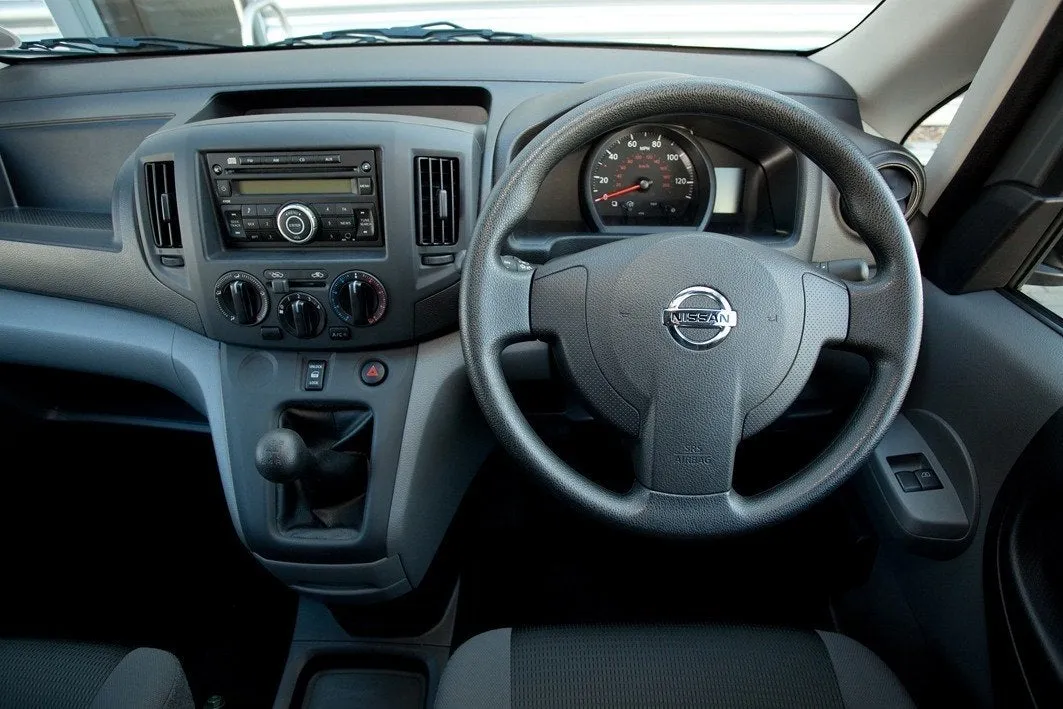
The simplicity of design means it is a dash that is easy to read, too, with large rotary dials to control the heating system and big toggles to move the air vents and that’s about it. The steering wheel is as simple as you can get, being perfectly round and devoid of buttons. However, there are audio controls tucked behind it for controlling other elements of the van such as the stereo.
You sit relatively high up in the NV200, which is a bonus, as it allows you a good view of the road ahead and to either side. The driver’s seat, while basic, is supportive and the result is a comfortable if slightly upright driving position as you don’t have to shuffle around to be able to see out. It’s a shame the steering wheel only adjusts up and down and doesn’t go in and out, though. There are some oddities – the door window switch sits on a little platform that juts out of the door and it’s positioned in such a way that it might bash your leg.
Despite there only being two seats in the NV200, the gear lever is also set up high, which minimises the distance you have to reach down and frees up more space lower down in the cabin.
Quality and finish
The materials on display are definitely ones that are more geared towards a utilitarian life. They are hard and shiny throughout, with a few contrasting colours. The central console has a silver-coloured surround that is made of a particularly hard plastic.
This hard nature does at least convey a feeling that the cabin will at least take a fair beating. Alternatively, the fact that it is not a wildly attractive environment might mean that some will not worry about keeping it pristine – something to look out for on used versions.
There aren’t any upgrades to the look of the interior as you go up through the range. The only additional styling features are on the outside, with the top-level Tekna version getting 14-inch alloy wheels and body coloured bumpers front and rear.
Infotainment
The good news is that a high proportion of NV200s will have come with an infotainment screen as it was a standard-fit feature on the mid-range Acenta model and upwards.
This is particularly good as the basic version only gets a simple stereo with two speakers and an AM/FM radio with a CD player – no DAB digital radio here. However, if you have a phone that can access digital radio then the Bluetooth or aux and USB sockets will let you play it through the speakers.
Said touchscreen even comes with a reversing camera, which is a handy added extra. The screen is rather small, though, so reading the display can be quite tricky.
The top-level model gets satellite navigation as standard (it was optional on the mid-range version) but the age of the NV200 means it predated Apple Carplay and Android Auto, even at the end of its time on sale.
Space and practicality
The straight panel van version of the NV200 was only ever been available as a two-seater. Fitting three seats in the front would have been a tricky task, though, given that the Nissan is a relatively narrow vehicle. Because there are only the two seats this isn’t particularly an issue, though, not as far as passenger space is concerned anyway. It is a tall cabin, too, which means that drivers of all heights should have plenty of room.
There is a decent amount of storage in the NV200’s cab, too, with 13 different cubby holes and storage points dotted around. These include places for folders, invoices and phones. Although plenty of them are open and unsecured, there is also one under the driver’s seat so you can stash things out of sight. The storage box between the front seats is a bit odd, though, given it is designed to have things placed on it but it’s front hinged so opening it could send oddments all over the cabin.
There are several handy touches, too, such as the passenger seat that can be tipped forward to create a flat desk, while the bulkhead can be opened out to slot longer items through from the loading area.
Said loading area also benefits from the taller than average height, while it also has a very low sill height which makes loading heavy items easier. The load length is just over two metres, and up to 2.8m when the load hatch is fitted.
The overall space is excellent, with 4.2 cubic metres of room in the back – more than long wheelbase versions of its contemporaries such as the Renault Kangoo.
The one element where the NV200 doesn’t match up to rivals is payload. The 795kg maximum carrying capacity is decent but still falls short of that offered by rivals. Modern rivals like the Citroen Berlingo and contemporaries like the Fiat Doblo and Vauxhall Combo are all capable of taking more than a tonne.
Handling and ride quality
"The NV200 is a relaxed van to drive in many senses."
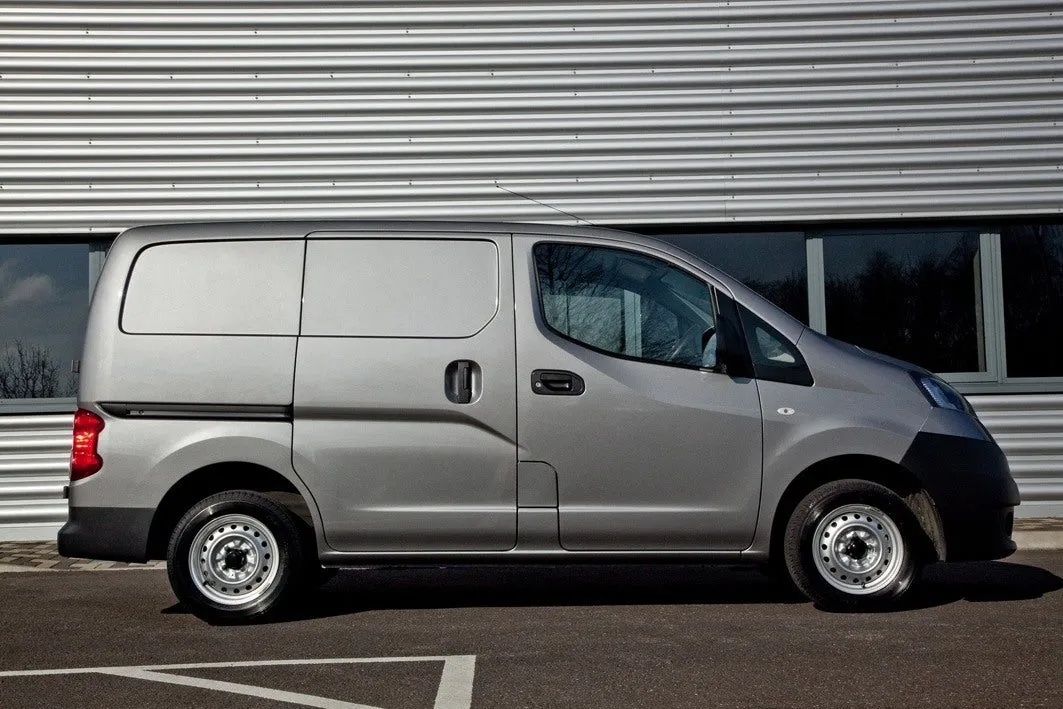
The steering is quick to respond and does so in an accurate way, which makes it quite an entertaining van to drive. It offers an impressive amount of grip through the corners, too, while there is a commendable lack of body lean when you carry a little bit more pace through a bend.
This should help keep loads in the back from flying around as much, but it does come at a slight price. The trade-off for that stability is a slightly firmer ride, particularly when you come across a rougher patch of road. You could never describe it as uncomfortable, but the NV200 is not as settled as the likes of the Citroen Berlingo, which smooths out more of the roughness by comparison.
The wheels don’t harm this, though, as the biggest alloy you can get on the NV200 is only a comparatively small 14 inches. They are quite skinny, but this doesn’t have a negative impact on the ride either.
These tiny wheels help around town, though – it is happiest on urban roads and it has an impressive 10.6m turning circle.
The e-NV200 comes with a slightly different setup, designed to deal with the extra bulk and different weight distribution caused by the batteries. The beefed-up suspension does thump into bumps in the road with a bit of a jolt sometimes, but it is still excellent the majority of the time.
Engines and gearboxes
The NV200 was offered with just the one 1.5-litre diesel engine for the entirety of its life and for the first couple of years of that time it was only available with a 90PS power output.
This version was a Renault diesel that was paired with five-speed manual gearbox – there was no automatic model offered at any time in the NV200’s history – and it was an engine that was most suited to life in town. While it feels nippy at lower speeds, it has to be worked harder on faster roads to keep up with the traffic.
In 2011, a 110PS engine was added to the range, which was a better bet in all situations. The turbodiesel unit boasts a healthy amount of low-down acceleration, which means it offers plenty of urgency for nipping into gaps in town traffic and is adept and getting up to speed on motorway sliproads alike.
The higher-powered version also gets an extra gear, with a six-speed manual the only option. This version is the better of the two and makes the 110PS the preferable option. It is a light, precise gearbox and, along with the light clutch, makes the NV200 easy to drive in town.
The EV model uses the same battery and motor as the Nissan Leaf, and is gloriously smooth, with the instant torque of an electric powertrain meaning that the e-NV200 is rapid away from a standing start in normal mode. The single-speed gearbox makes it all the smoother.
Refinement and noise levels
The NV200 is impressively quiet, regardless of which model you go for – it is one of the quietest vans of its class. It manages to keep engine, road and wind noise out of the cabin at higher speeds when others, like the Volkswagen Caddy, can become wearing.
The one factor that makes a difference is the gearbox. The 110PS model comes with a six-speed transmission, whereas the 90PS gets a five-speed ‘box. The five-speed unit is noisier than the six-speed version on the motorway – it sits at higher revs which produces more engine noise. It’s still not noisy by van standards, but the six-speed is the quieter of the two.
Quietest of all, though, is the e-NV200. The engine is almost totally silent, which means that you notice what little wind and road noise there is. The huge side mirrors and upright stance mean there is a little wind noise as you go faster, but it is really very little.
Safety equipment
As is the norm with vans, only the driver gets an airbag as standard on the entry-level NV200. However, a passenger airbag is an option on the mid-spec trim and standard on the top-end model. The options list also offers curtain airbags for the Combi model, although not for the van version.
The rest of the standard safety kit is comparable to rivals, in that it is simple and covers the basics. It does get an alarm and immobiliser as standard, though, which is not universal in the class. Rear parking sensors are another option, but there are no intelligent driving systems available at all.
The standard van wasn’t crash tested by EuroNCAP, but the passenger version of the e-NV200 was. This only scored three stars in 2014, with the low rating largely due to a 38% score for its safety assist systems. It scored better in both the adult occupant (75%) and the child occupant (80%) categories.
A full-size spare wheel is another standard-fit feature.
Maximum EV range
The official range of the e-NV200 is a relatively impressive 124 miles for the most recent version, but it hasn’t always been that. The earlier models had a theoretical 106-mile range, but a bigger battery was added in 2017.
It has an Eco mode that will help make the most of this range, but the distance you manage to travel in the real world will depend to a large extent on how much stuff you have in the back. In any case, it is likely to be a van that you have to plug in each night at the end of your shift.
MPG and fuel costs
"Both versions of the 1.5-litre diesel engine claim the same official economy – an impressive sounding 53.3mpg. However, this is calculated using the older NEDC test as the NV200 was no longer on sale by the time the new WLTP test came in. You should be able to see around 80% of this though, which means that an economy in excess of 40mpg should be possible."
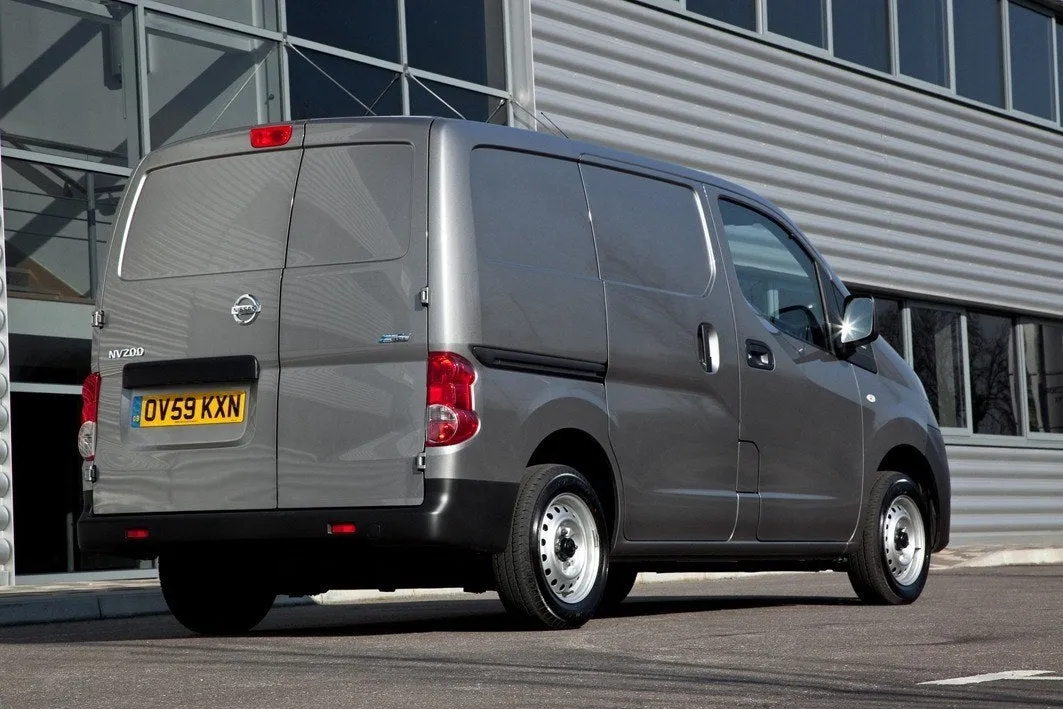
The 40kWh battery can be recharged to 80% in about 40 minutes to an hour on a quick charger. Charging to capacity takes around 7.5 hours on a 6.6KW charger. Charging it on a three-pin plug is less appealing, though, with it taking 21.5 hours. The basic version comes with the ability to charge on the 6.6KW charger, while mid-level Acenta gets rapid charging ability.
Insurance groups and costs
There is very little difference between the different panel van versions, with the basic model sitting in group 5E and the range-topper in 6E. The crew van and the combi are both more expensive to insure, sitting in groups 10E or 11E. This is the case regardless of whether you go for the five-seat version or the seven-seater.
VED car tax
The Nissan NV200 is taxed as a van so is eligible for the flat-rate, low commercial vehicle tax. It is also therefore eligible for the flat-rate Benefit-in-Kind tax that applies to commercial vehicles.
How much should you be paying for a used Nissan NV200?
"Van used prices are often more aligned to the life they have led – mileage and condition can have more of an impact on value than original specification."
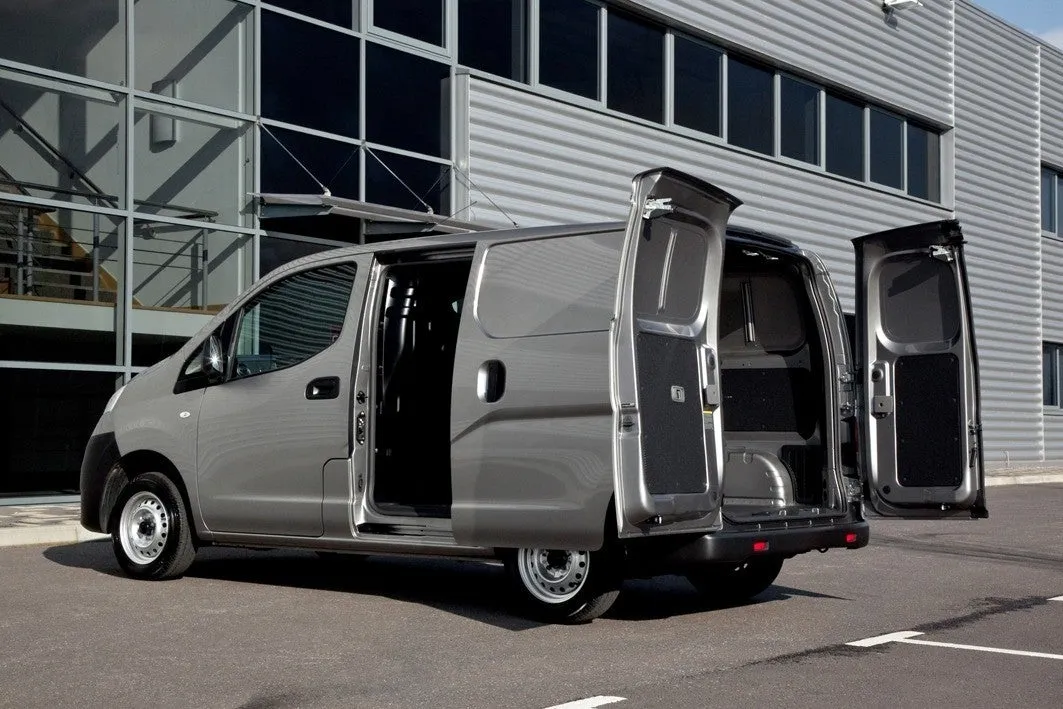
Picking up a three-year-old model should be possible for just under half the original price, so in the case of a Tekna model you should be looking at around £7,000 for one that has covered around 60,000 and is in average condition.
The crew van shouldn’t add more than a couple of hundred pounds to the price.
Trim levels and standard equipment
Given there is little difference between the two versions of the 1.5-litre diesel engine, the more powerful 110PS is the better option. It feels more settled on the motorway thanks to its sixth gear and it has a welcome turn of speed that helps it feel nippier around town.
The Tekna model is the pick of the range, largely because the other versions miss out on some basic kit like air conditioning. Thankfully the financial step between the different models was never huge when the NV200 was new so it shouldn’t be big now it is only a feature on the used market.
Ask the heycar experts: common questions
Is the Nissan NV200 any good?
What is the payload of the Nissan NV200?
How many people can a Nissan NV200 carry?
What engine does the Nissan NV200 have?
Get our latest advice, news and offers
Keep me updated by email with the latest advice, news and offers from heycar.
By submitting you agree to our privacy policy
